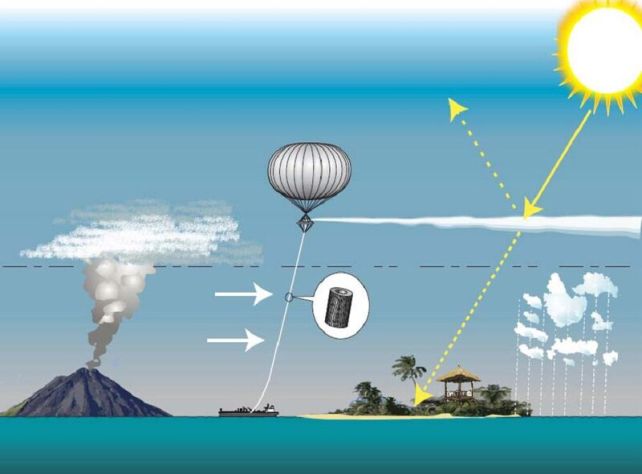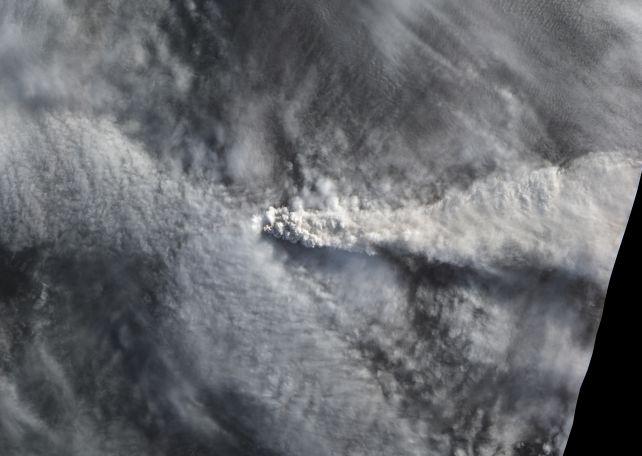Spraying particles into Earth's atmosphere to try and cool a warming planet might sound like a good idea in theory, but it will only work if it's done properly – and even then, it could carry risks that might spill beyond our control, scientists caution.
According to a team led by aerosol scientist Miranda Hack of Columbia University in the US, there are real-world logistical, engineering, and political limitations that mean any stratospheric aerosol injections (SAI) intended to reduce global warming should be considered extremely carefully before any attempt is made.
"There are a range of things that might happen if you try to do this – and we're arguing that the range of possible outcomes is a lot wider than anybody has appreciated until now," says atmospheric chemist and aerosol scientist V. Faye McNeill of Columbia University.
Related: Injecting Diamonds Into The Sky Could Cool The Planet, Study Says

As our planet continues to warm at an alarming rate, scientists have sought to investigate potential mitigation strategies.
Solar geoengineering by way of SAI is what it sounds like: seeding our middle atmosphere with aerosols that reflect some of the Sun's light back out into space, so our planet has less heat to absorb.
This idea might sound wild, but it's based on a natural phenomenon: When a volcanic eruption spews tons of ash into the stratosphere, it has a short-lived cooling effect, with the ash and dust blocking some of the Sun's rays. (Erupting volcanoes also belch heat-trapping greenhouse gases, so volcanism can warm our planet on longer time scales.)
This observed cooling effect led scientists to hypothesize that certain aerosols could help mitigate the effects of global warming caused by humans' predilection for burning fossil fuels.
Computer models simulating SAI are delivering promising results, but those models are not necessarily reflective of what would happen in a real-world scenario, the researchers say.
"Even when simulations of SAI in climate models are sophisticated, they're necessarily going to be idealized. Researchers model the perfect particles that are the perfect size," McNeill says.
"And in the simulation, they put exactly how much of them they want, where they want them. But when you start to consider where we actually are, compared to that idealized situation, it reveals a lot of the uncertainty in those predictions."

The researchers wanted a more realistic sense of how an SAI attempt might play out, so they conducted their own analysis, examining deployment strategies, governance options, supply chains, and the hard physics of spraying materials into the atmosphere.
The researchers found that the optimum deployment strategy would see SAI controlled by a single, internationally coordinated, and centralized governing body.
This would be especially important for guiding where aerosol particles are released: SAIs at mid-latitudes can alter atmospheric heat transport patterns, potentially affecting polar regions.
Meanwhile, releasing aerosols at higher altitudes would increase the time for which they remain airborne, but could weaken the polar ozone layer. And multiple aerosol releases over time would be more effective than one massive release, but that would require a long-term commitment.
However, that ideal governance scenario is unlikely, the researchers find, because geopolitical realities mean the world is currently not invested in that level of cooperation.
The alternative to centralized governance for SAI is several smaller, independently operating bodies doing their own thing, which would probably result in uneven cooling and shorter lifespans for potentially disjointed projects.
The next consideration is what material to use and how easy it is to obtain. Diamond and zircon dust are some of the potentially more effective propositions, but the modeled SAI demand would be comparable to or exceed current global production rates for those materials, making them unsuitable candidates.
"Scientists have discussed the use of aerosol candidates with little consideration of how practical limitations might limit your ability to actually inject massive amounts of them yearly," Hack says.
"A lot of the materials that have been proposed are not particularly abundant."
Even supply chains for materials that are more abundant, such as lime and sulfur, could be strained by the demand exacted by SAI.

These mineral options present another problem, too: At the submicron sizes required by SAI, they tend to clump together. The clumps would be much less efficient at cooling than an evenly spread cloud of particles, thereby reducing the desired cooling effect.
Taken together, the analysis suggests that a lot more work needs to be done before SAI can be considered even a remotely viable strategy.
"These practical limitations, if left unaddressed, push SAI scenarios further away from the idealized scenarios explored in the literature," the researchers write in their paper.
"A more complete understanding of 'worst-case' tropospheric climate impacts through global climate model runs that simulate aggregate injection might better contextualize these results and allow for a more complete risk-risk picture."
The research has been published in Scientific Reports.

